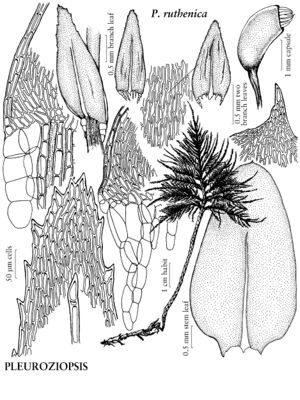FNA>Volume Importer |
FNA>Volume Importer |
||
| Line 42: | Line 42: | ||
|publication year= | |publication year= | ||
|special status= | |special status= | ||
| − | |source xml=https://jpend@bitbucket.org/aafc-mbb/fna-data-curation.git/src/ | + | |source xml=https://jpend@bitbucket.org/aafc-mbb/fna-data-curation.git/src/f6b125a955440c0872999024f038d74684f65921/coarse_grained_fna_xml/V28/V28_796.xml |
}}<!-- | }}<!-- | ||
-->[[Category:Treatment]] | -->[[Category:Treatment]] | ||
Revision as of 19:47, 24 September 2019
Plants medium-sized to large, in loose to somewhat dense tufts, glossy. Stems with primary stems creeping, secondary stems erect, frondose-dendroid, pinnate and 2-pinnate; lamellae many, on branches and branchlets, of 1–4 cells, attached to epidermal cells of stems and abaxial surface of leaf base and costa, lamellae cells hyaline, inflated, smooth, walls thin; paraphyllia and pseudoparaphyllia absent; rhizoids on primary and secondary stems many, whitish or reddish brown, much-branched, papillose, those on secondary stems, branches, and branchlets on apical laminal cells, usually dichotomously branched, smooth. Secondary stem leaves erect, complanate to slightly concave, oblong-ovate; apex apiculate. Branch and branchlet leaves erect-spreading; base long-decurrent; costa single; alar cells many, hyaline, inflated; medial laminal cells elongate, vermicular. Sexual condition dioicous. Sporophytes lateral on stem. Seta elongate. Capsule cernuous, ovoid, arcuate; peristome hypnaceous, double; exostome teeth trabeculate; endostome cilia absent. Spores 12–24 µm.
Distribution
nw North America, e Asia, temperate regions.
Discussion
Species 1.
The family Pleuroziopsaceae was established solely for the genus Pleuroziopsis (R. R. Ireland 1968), primarily because of the unique stem lamellae first reported by A. Noguchi (1952b). The lamellae are abundant on the branches and branchlets and, in addition to being attached to the stems, they are attached to the abaxial surface of the leaf bases and proximal costa. The pinnate and 2-pinnate branching pattern, the ovoid, arcuate, cernuous capsule with hypnaceous peristome, and the absence of paraphyllia are additional morphological characters distinguishing this genus from Climacium. Recently, D. H. Norris and M. S. Ignatov (2000) discovered (1–)2–3-stratose longitudinal streaks (stem lamellae) on the stems of C. dendroides growing intermixed with Pleuroziopsis from. These lamellae are scattered along the stems of C. dendroides, the only species of Climacium in which they were observed. Whether or not these lamellae are morphologically similar to those of Pleuroziopsis is debatable. The lamellae of Pleuroziopsis, which are numerous, are attached to the leaf bases, the costa, and the epidermal cells of the branch and branchlet stems, continuing proximally toward the leaf below. The lamellae of C. dendroides are not attached to the leaf bases or costa, only to the epidermal stem cells. In addition to the lamellae, the authors noted that the structures referred to as paraphyllia in Climacium are actually rhizoids, just as they are in Pleuroziopsis. It is primarily because of stem lamellae that the authors believe Pleuroziopsis should be placed back in Climaciaceae. Capsules of Climacium and Pleuroziopsis are quite different (Ireland). The value at the familial level is not as important, since reduced peristomes are known to occur in some families of pleurocarpous mosses, as Ignatov et al. (1998) have pointed out for Brachytheciaceae.
